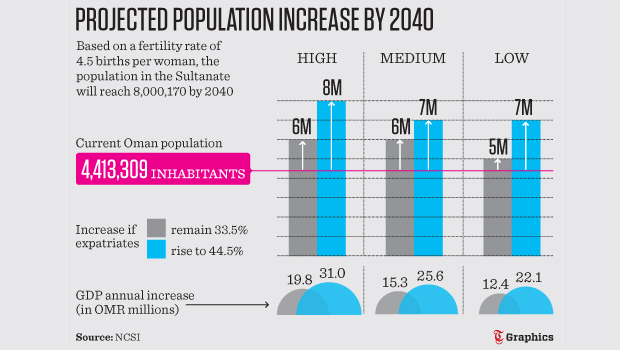
Muscat: Oman’s population will exceed 8 million by 2040, a study conducted by the National Centre for Statistics & Information (NCSI) has pointed out.
In the same period, the labour market will witness 568,000 new recruits.
The Sultanate will also see a number of development projects in the housing, electricity, water, health and education sectors, coming to fruition at an aggregate cost of over OMR2.9 billion, the study said.
**media[464090]**
The study envisaged three scenarios with regard to population growth: high, medium and low increase.
Assuming a high increase scenario ---based on a fertility rate of 4.5 births per woman, and 44.5 per cent of the population expected to be expatriates ---the number of Sultanate’s inhabitants will reach 8,000,170 in 2040, while it would be 6,000,770 if expatriates account for 33 per cent of the total population.
With per capita GDP standing at the 2014 figure of OMR7,863, the high increase in population scenario will translate into an annual increase in gross domestic product to the tune of OMR31 billion during 2016-2040. Annual increase in GDP is estimated at OMR19.8 billion if percentage of expatriates remains low.
Assuming a higher annual growth in per capita gross domestic product at OMR37,545 (according to a World Bank study), the increased output will reach OMR269 billion (keeping expatriates at 44.5 per cent) while it will be OMR216 billion if expatriates make up 33 per cent of the population.
Also, as many as 568,000 people will enter the labour market, of which 371,000 would be males.
Oman will also need 576,000 new housing units, consuming 11,120 thousand Giga Watts/extra hour of electricity and an additional OMR336 million to cover the cost of maintaining electricity production.
The Sultanate may require 63.8 billion additional gallons of water entailing and additional spending of OMR377.2 million for the production of household water (if expatriates form 44.5 per cent of total population).
Assuming a 33 per cent expatriate population, the Sultanate may need 376,000 new housing units with the addition of 7093 GW/additional hour energy consumption requiring an expenditure of OMR214 million in terms of household electricity; and an additional 40.7 billion gallons to meet water needs requiring a spending of OMR240.6 million for the production of household water.
The health sector will need to add 13,115 doctors, 2,146 pharmacists and 25,832 nurses, which will require a spending of OMR758.6 million (expatriates at 44.5 per cent). Considering a lower share of expatriates, the health sector will need 8,365 doctors, 1,369 pharmacists and 16,476 nurses which will entail an expenditure of OMR483.9 million.
As many as 2.2 million students will join the school education system, which requires 64,242 additional teachers and 21,796 classrooms with an estimated expenditure of OMR1.428 billion.
Oman’s population in 2040 will be approximately be 7,000,490 people, assuming 44.5 per cent expatriates; while population will be 6,000,200 thousand at a lower percentage of expats (33 per cent).
Gross domestic product is estimated to grow annually at OMR25.6 billion during the period from 2016 to 2040 (at higher expat population), while the annual increase will be OMR15.3 billion at lower expat population.
As many as 549,000 people will enter the labour market, which will include 360,000 males.
Oman will also need 477,000 new housing units and 9,203 GW/additional hour of household electricity and an additional OMR278 million to cover the cost of maintaining electricity. The situation may need an additional 52.8 billion gallons of water requiring an additional expenditure of OMR312.1 million to produce household water.
Assuming a 33 per cent expat population, the Sultanate may need 285,000 new housing units with the addition of 5,504 thousand Giga Watts/additional hour, entailing an expenditure of OMR166 million on household electricity; and an additional 31.6 billion gallons of water requiring an expenditure of OMR186.7 million for the production of water.
The health sector will need to add 10,854 doctors, 1,776 pharmacists and 21,379 nurses entailing an expenditure of OMR672.9 million. At a lower expat percentage, the health sector will need to add 6,493 doctors, 1,062 pharmacists and 12,788 nurses requiring a spending of OMR375.6 million.
Nearly 1.95 million students are expected to join the school education system, requiring the services of 45,770 additional teachers and 15,529 classrooms which will require a spending of OMR1.9 billion.
At a fertility rate of 2.5 births per woman, the population of the Sultanate will be approximately 7,000,003 thousand people assuming expatriates make up 44.5per cent of the population; and 5,000,820 thousand inhabitants in the case of the low percentage of expats (33per cent).
Annual increase in gross domestic product is estimated at OMR22.1 billion during the period from 2016 to 2040 (at higher expat percentage), while the rise will be OMR12.4 billion otherwise. The GDP output will reach OMR226 billion or OMR181 billion depending on high/low expat population.
As many as 536,000 new people will enter the labour market, of which 353,000 will be males.
Oman will also need 411,000 new housing units and 7,931 GW/additional hour for the consumption of household electricity; and an additional OMR239 million to cover the cost of maintaining the electricity. It needs 45.5 billion additional gallons of water requiring an expenditure of OMR269 million to produce household water.
Assuming lower expat population, Oman will need 231,000 new housing units with the addition of 4,450 GW/additional hour needing an expenditure of OMR134 million on household electricity; and an additional 25.5 billion gallons of water entailing a spending of OMR151 million for the production of household water.
The health sector will need to 9,353 doctors, 1,531 pharmacists and 18,423 nurses requiring a spending of OMR541 million (expats forming 44.5 per cent of population). At a lower expat population, the health sector will need to add 5,250 doctors, 859 pharmacists and 10,340 nurses at a spending of OMR303 billion.
Also, nearly 1.8 million students will join the school education system, which will require 40,176 additional teachers and 13, 631 classrooms at a spending of OMR729 million.